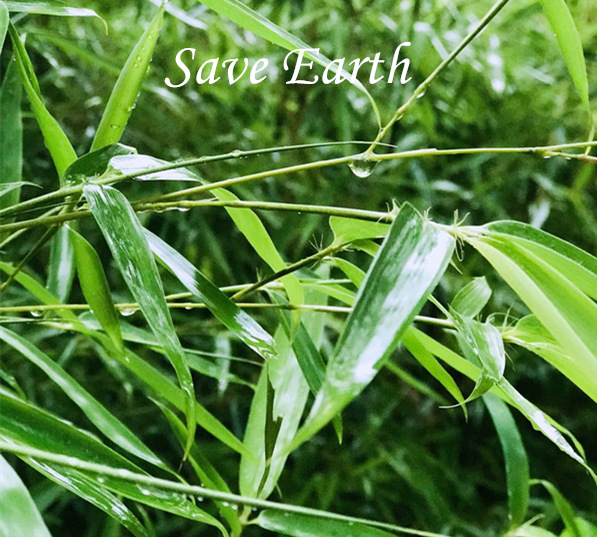
By Qian Ding, CCTV.com reporter
When two teenagers went on stage to present their journey in Africa, I wasn't expecting much spectacular until they showed a scientific chart in which they recorded details of their observations on acacia farnesiana. Via tracking growth conditions of the plant, they estimated the quantity of food resources for wild animals living in the area. They also learned to map the movement range of elephants inhabited there by counting and checking out their dungs. After paying a visit to the last male northern white rhino- Sudan before it passed away, they felt deeply concerned about wild rhinos. The girls said, "the guards are very brave, but they don't have equivalent weapons to protect wild animals from well-armed poachers. We have a long way to go to protect animals and our mother earth."
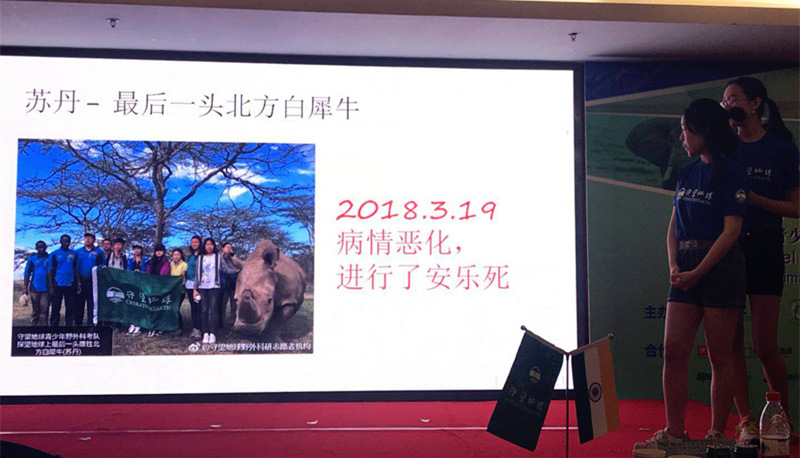
Volunteers presenting their photo with the last male northern white rhino- Sudan before it was euthanized on March 19. (Photo/Qian Ding)
The girls did the 15-minute long presentation in their mother tongue-Chinese and fluent English at an event named, "Climate change and world peace" on May 27 in Beijing, China's capital. The event was held by Operation Earth, China's first international field research volunteers organization. Two girls' inspiring and touching experience in Africa won much applause from the audience, including Chen Zhongliang, founder of Operation Earth and expert of United Nations Environment Program (UNEP) as well as Rajendra Shende, leading Indian expert of Intergovernmental Panel on Climate Change (IPCC).
Two girls' vision for the world and determination on environment protection left us with a positive impression of the world's future, that despite of all the negative reports about today's youth who seem spoiled and obsessed with digital products, our younger generation care about the earth. According to Operation Earth, more than 3000 volunteers have joined field research projects conducted worldwide through their platform, and have volunteered more than 100 thousands hours in total.
The event was highlighted by the launch of "Sino-India Youth Field Research Expedition Fund." The fund is implemented to sponsor Indian teenagers to participate in field research programs held in China, promote bilateral communications on ecological monitoring, biodiversity conversation and other environment protection issues.
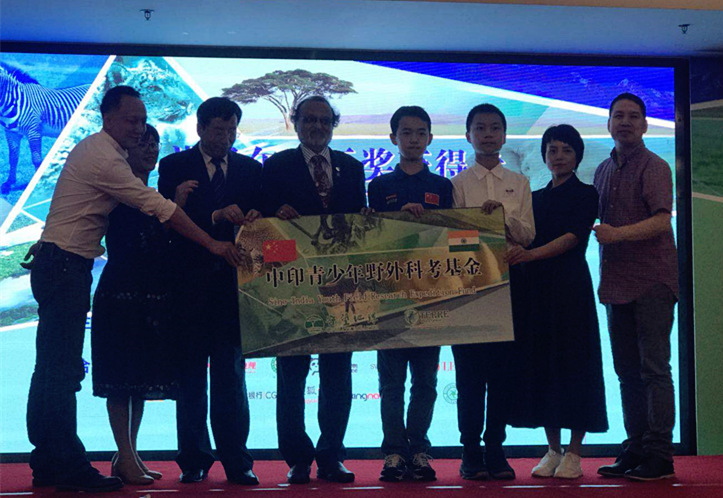
Leading Indian expert of IPCC, Rajendra Shende; founder of Operation Earth and expert of UNEP, Chen Zhongliang and representatives of volunteers, companies and schools launched the "Sino-India Youth Field Research Expedition Fund" together on May 27 in Beijing. (Photo/Qian Ding)

A sale of panda dolls and cushions for "Sino-India Youth Field Research Expedition Fund" was held at the event, 10 RMB (about U.S $1.6) of each sale goes to the fund to sponsor Indian teenagers to come to China for joint field researches. (Photo/ Qian Ding)
China and India, which together account for 35 percent of the world's population and a quarter of the world economy, share many similarities. Both are ancient civilizations facing modernization challenges, they are enjoying fast economic development, with India's current growth rate at 7.2% and China's economy grew 6.8 percent in the first quarter of 2018, and both countries are struggling with deadly pollution. According to the World Health Organization, New Delhi, India's capital, is the most polluted maga-city in the world with highest concentration of the pollutant PM10. Mumbai, India's financial hub ranked fourth on the list followed by Beijing, China's capital.
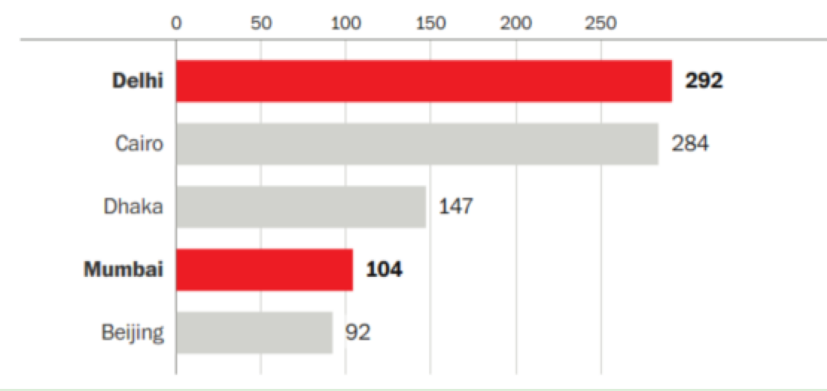
WHO compared the pollutant PM10 in cities with a population of over 14 million from 2010-2016. (Photo/World Health Organization)
WHO also analyzed the level of PM2.5, a smaller and more deadly pollutant, situation seems worse in India where 14 of the top 15 most polluted cities are located. Kanpur, India's industrial hub ranked No.1.
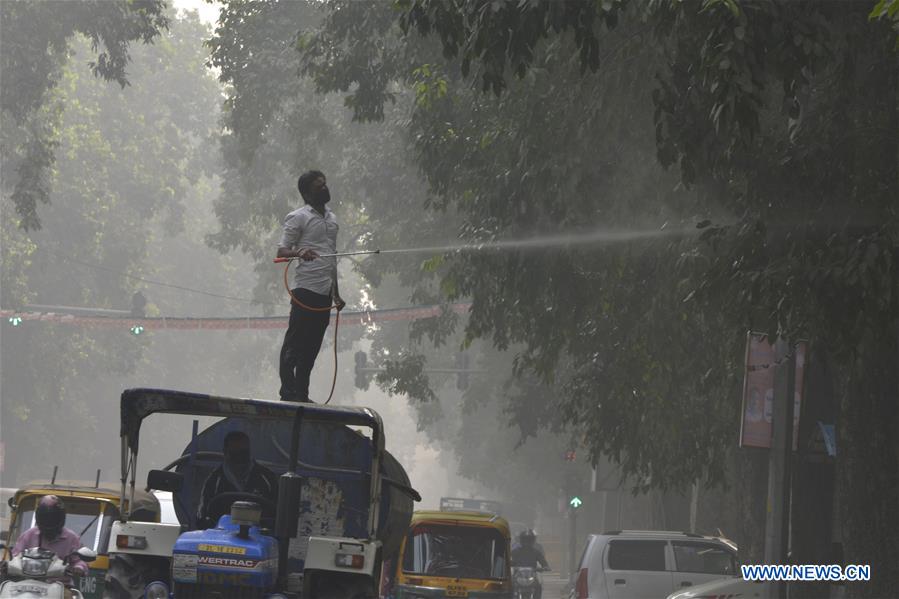
Municipal worker sprays water on the trees to settle dust as measure against ongoing heavy pollution in New Delhi, India on Nov. 9, 2017.(Xinhua/Sarkar)
According to the latest air quality database, 97% of cities in low- and middle- income countries with more than 100,000 inhabitants do not meet WHO air quality guidelines. Nine out of ten people worldwide breath polluted air, which is responsible for the deaths of 7 million people each year globally. 25% of all heart disease deaths, 43% of all lung disease and lung cancer deaths and 24% of all stroke deaths are attributable to air pollution. The number of people killed by air pollution is twice the number of deaths caused by AIDS, malaria and tuberculosis combined.
Beijing has taken steps to clean up its air. New coal-fired plants are prohibited in China's most polluted regions, existing coal plants were replaced with natural gas. Beijing, Shanghai and other big cities restricted the number of cars on the road. Li Ganjie, Minister of Ecology and the Environment, said in an environmental report delivered to a bimonthly session of the National People's Congress Standing Committee, that China has attained most of its environment protection goals in 2017. The ratio of days with good air quality in 2017 stood at 78%, and density of major pollutants such as PM2.5 and PM10 dropped significantly.
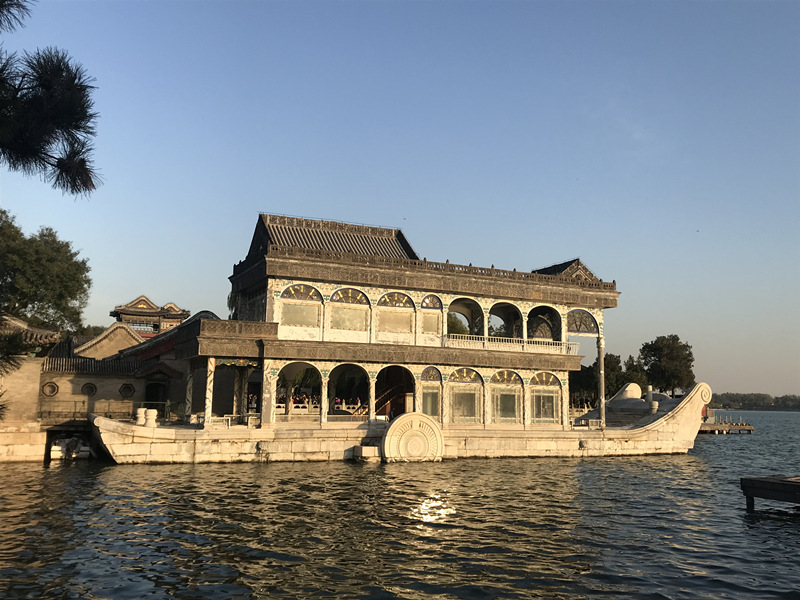
Air pollution has been notably reduced in Beijing, especially during winter months in 2017. (Photo/ Li Shouen)
India, which hasn't formed a state level strategy against pollution besides occasional bans such as no sales of fireworks in Diwali, is encouraged to follow China's lead. The WHO's head of public health, Maria Neira, told Reuters news agency, "We would be very happy if we would see a similar movement now in India, which is one of the countries for which we are particularly concerned, although there are good initiatives which can be put in place quickly, still the levels are very high and we would like to see a similar decision and leadership."
China and India have signed an agreement to coordinate their approach on climate change in 2009. But with the off and on heated political arguments such as Sino-Indian land border dispute, cooperation between the two sides is not going smoothly. India says it is getting only 1 percent of 150 million Chinese traveling overseas and China buys only about 4 percent of India's exports.
But against all odds, cultural and personnel exchanges between the two countries are surging. Personnel exchanges in 2017 exceed 1 million. There are 14 pairs of sister city/province including New Delhi and Beijing, Bangalore and Chengdu, Kolkata and Kunming. 42 flights operate between the two countries weekly. And it's a trend for the Chinese to watch Bollywood movies, "Dangal" and "Hindi Medium" even became blockbusters in Chinese box office. Yoga practice is not just a fashion in urban areas, but also getting popular in rural China.
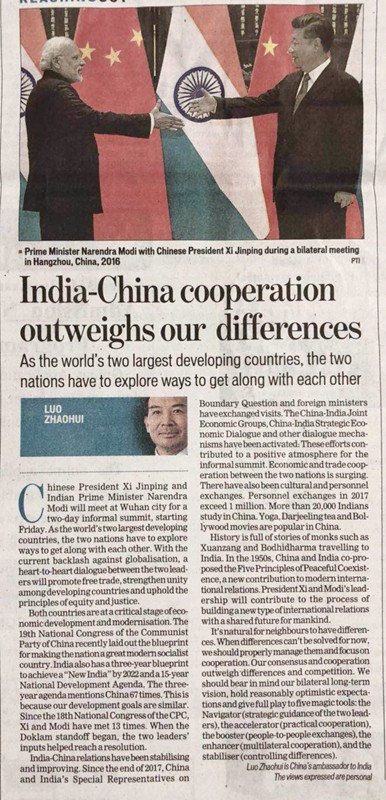
On April 26, 2018, Indian Newspaper The Hindustan Times published the article "India-China cooperation outweighs our differences" of Chinese Ambassador to India Luo Zhaohui. (Photo/ Ministry of Foreign Affairs of the People’s Republic of China)
In order to protect world environment, China and India, as the two largest developing countries and major emerging markets, need to explore ways to get along with each other and tackle pollution problems side by side. The cooperation should not only be conducted at state level, but also by people, especially youth, the future of our mother earth.
(The opinions expressed here do not necessarily reflect the opinions of Panview or CCTV.com. )

Panview offers a new window of understanding the world as well as China through the views, opinions, and analysis of experts. We also welcome outside submissions, so feel free to send in your own editorials to "globalopinion@vip.cntv.cn" for consideration.
















